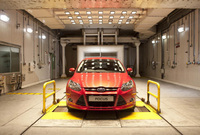Ford develops red hot chilly Focus in the UK

At Ford's Dunton research and engineering centre, technicians can recreate the worst weather imaginable. They can raise the temperature to a sweltering 55 degrees Centigrade. They also do extreme cold rather well. With 28 tonnes of refrigerant to call on, mercury can be made to read a mind-numbing minus 40 degrees.
Dunton's Environmental Test Lab is one of the most advanced facilities of its kind. Costing over £26.5 million, it provides four test chambers (two with thermodynamic wind tunnels), six rooms in which to 'soak' vehicles from -40 to +55 degrees Centigrade and a vehicle preparation workshop. The lab even has two altitude chambers which can simulate between 100 metres below sea level and 4,000 metres above.
Ford's all-new Focus has spent thousands of hours inside the laboratory to ensure it will cope with anything mother nature throws at it. "The new Focus was tested in real-world conditions but this is always limited by the prevailing weather," said Bruce Thirkettle, Environmental Test Lab supervisor.
The cold start test is one example in the lab's repertoire. Once the vehicle has been soaked at -30 degrees for 16 hours, it is transferred to a test chamber at the same temperature and placed on a rolling road. The engine is fired up and driven a short distance to ensure it fully functions. Extreme cold puts huge demands on an electrical system to supply energy to crank the engine at the speed required to establish combustion, as well as to other parts such as glow plugs, injectors and spark plugs.
Another test is called air con pull down, when a vehicle is heated to +50 degrees before the engine is turned on and the air conditioning is timed to see how long it takes to cool the cabin to a comfortable temperature.
More than half of testing undertaken at the Dunton lab is engine calibration work using chassis dynamometers, which can simulate road speeds of over 150mph. The two wind tunnels can generate wind speeds up to 140mph.
"The main advantage of testing here is that we can precisely recreate conditions at any time of the year," said Bruce. "Temperature accuracy is within plus or minus 0.6 of a degree, humidity to within 0.7 per cent and altitudes to plus or minus 10 metres. It’s an exact science that means any vehicle performance changes are down to components and not any variation in the environment.
"We torture test vehicles here, so customers can enjoy worry-free motoring in Ford vehicles from launch."

